Preparation of Advisory Report on Chronic Obstructive Pulmonary Disorder (COPD)
VerifiedAdded on 2023/01/19
|12
|3952
|38
AI Summary
This advisory report provides a comprehensive overview of Chronic Obstructive Pulmonary Disorder (COPD), including its origins, mechanism of disease development, industries at risk, and burden in the UK. It also discusses strategies for prevention and management of COPD. Download now!
Contribute Materials
Your contribution can guide someone’s learning journey. Share your
documents today.
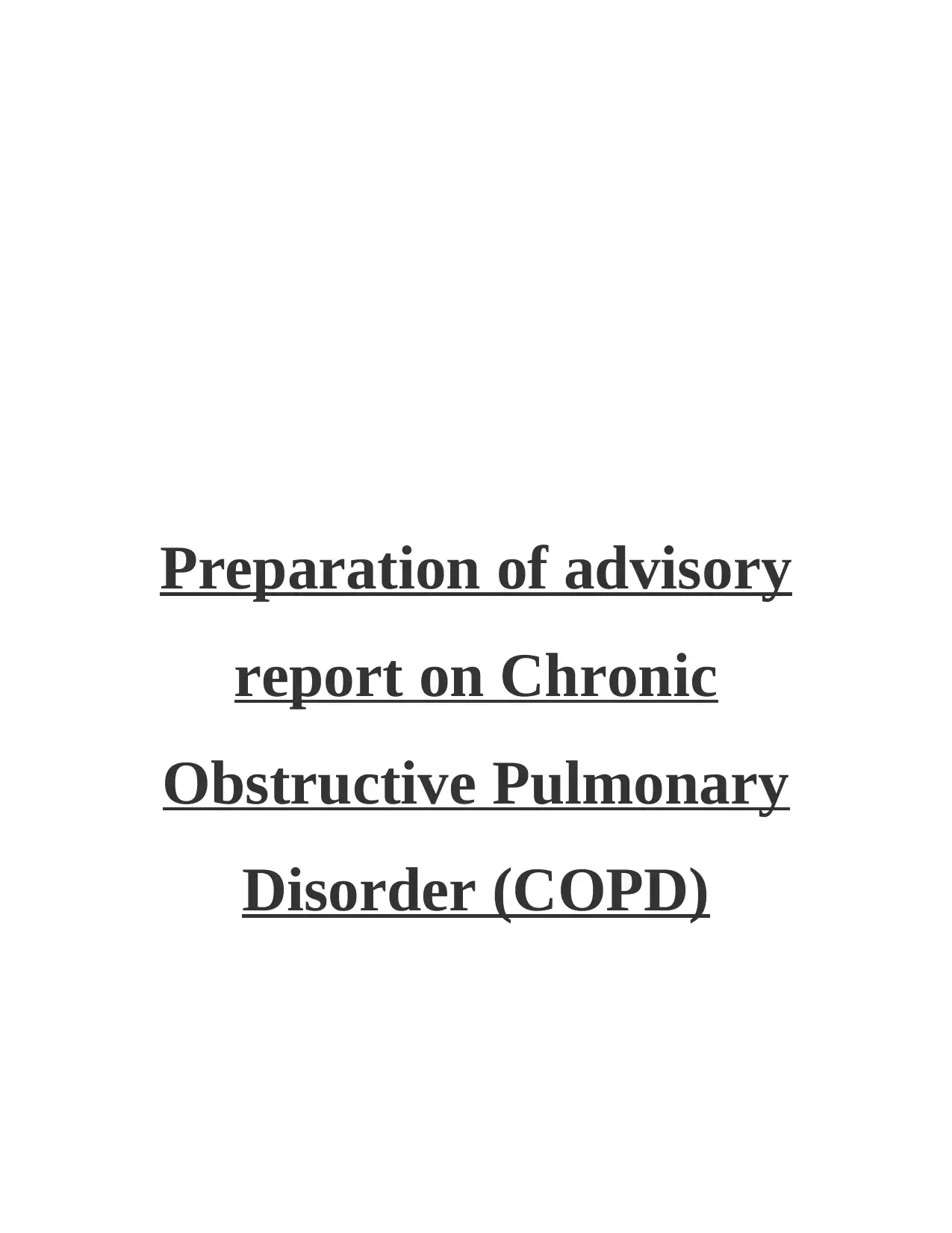
Preparation of advisory
report on Chronic
Obstructive Pulmonary
Disorder (COPD)
report on Chronic
Obstructive Pulmonary
Disorder (COPD)
Secure Best Marks with AI Grader
Need help grading? Try our AI Grader for instant feedback on your assignments.
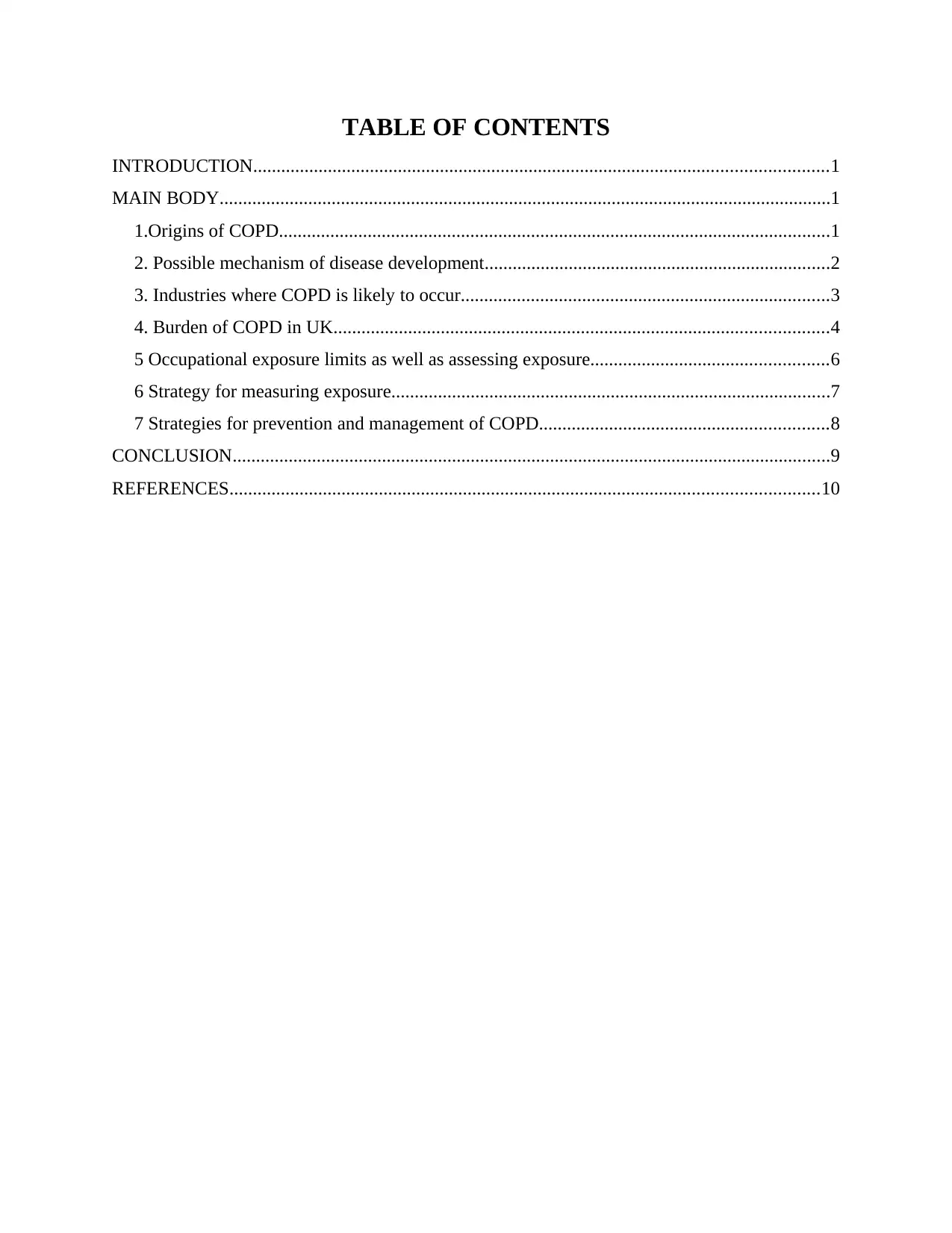
TABLE OF CONTENTS
INTRODUCTION...........................................................................................................................1
MAIN BODY...................................................................................................................................1
1.Origins of COPD......................................................................................................................1
2. Possible mechanism of disease development..........................................................................2
3. Industries where COPD is likely to occur...............................................................................3
4. Burden of COPD in UK..........................................................................................................4
5 Occupational exposure limits as well as assessing exposure...................................................6
6 Strategy for measuring exposure..............................................................................................7
7 Strategies for prevention and management of COPD..............................................................8
CONCLUSION................................................................................................................................9
REFERENCES..............................................................................................................................10
INTRODUCTION...........................................................................................................................1
MAIN BODY...................................................................................................................................1
1.Origins of COPD......................................................................................................................1
2. Possible mechanism of disease development..........................................................................2
3. Industries where COPD is likely to occur...............................................................................3
4. Burden of COPD in UK..........................................................................................................4
5 Occupational exposure limits as well as assessing exposure...................................................6
6 Strategy for measuring exposure..............................................................................................7
7 Strategies for prevention and management of COPD..............................................................8
CONCLUSION................................................................................................................................9
REFERENCES..............................................................................................................................10

INTRODUCTION
Chronic obstructive pulmonary disease (COPD), is a disease which occurs in lungs and is
characterised by a long term problem in breathing mechanism and also results in poor air flow in
an individual. There are various symptoms of COPD and some main symptoms includes
coughing, shortness of breath and excessive sputum production. It is a progressive disease which
keeps on worsening over a time. There are various causes of this disease is smoking which is a a
common factor for this disease another factor are genetics, air pollution, fog etc. Present report
discusses about the possible mechanism of COPD development and also includes the industries
where there is a chance of disease to occur to employees. This report also discusses about the
burden of this disease in United Kingdom and what are the occupational exposure limits for
exposure. Present report also includes various strategies for prevention and management of
COPD with reference to health surveillance and good practice guide.
MAIN BODY
1.Origins of COPD
There are various origins of COPD which give rise to this disease in individuals and
some of the caused are mentioned below:
Smoking: This is considered as the most common risk factor for COPD across the world which
is normally referred as tobacco smoking. People who smoke 20% of get COPD and particularly
for those who are lifelong smokers. Also, women become more susceptible for the harmful
effects of smoking than men. So smoking in considered as one of the major origin of this
disease. Also, pregnant women who smoke may increase chances of COPD in their child which
can develop various complications in the future like asthma, sputum production, etc.
Air pollution: This is also one of the major origin of COPD which have affect the huge
population of the world especially people who are living in polluted cities and working factories.
Burning of fossil fuels like wood, coal, dung, and poorly ventilated cooking fries and industries
which lead to the indoor pollution is considered as one of the major factor for causing COPD in
developed and developing countries of the world (Vedel-Krogh and et.al 2016). Poorly ventilated
factories and frying methods which cause heath effects to people work in these factories and
kitchens. Also, people who live in major cities of the world have a great risk of COPD in them as
compared to people who love in rural areas. Due to rise in urbanisation, also gives rise to
pollutions like increase in co2, No, No3, methane gases which also result in COPD. There are
Chronic obstructive pulmonary disease (COPD), is a disease which occurs in lungs and is
characterised by a long term problem in breathing mechanism and also results in poor air flow in
an individual. There are various symptoms of COPD and some main symptoms includes
coughing, shortness of breath and excessive sputum production. It is a progressive disease which
keeps on worsening over a time. There are various causes of this disease is smoking which is a a
common factor for this disease another factor are genetics, air pollution, fog etc. Present report
discusses about the possible mechanism of COPD development and also includes the industries
where there is a chance of disease to occur to employees. This report also discusses about the
burden of this disease in United Kingdom and what are the occupational exposure limits for
exposure. Present report also includes various strategies for prevention and management of
COPD with reference to health surveillance and good practice guide.
MAIN BODY
1.Origins of COPD
There are various origins of COPD which give rise to this disease in individuals and
some of the caused are mentioned below:
Smoking: This is considered as the most common risk factor for COPD across the world which
is normally referred as tobacco smoking. People who smoke 20% of get COPD and particularly
for those who are lifelong smokers. Also, women become more susceptible for the harmful
effects of smoking than men. So smoking in considered as one of the major origin of this
disease. Also, pregnant women who smoke may increase chances of COPD in their child which
can develop various complications in the future like asthma, sputum production, etc.
Air pollution: This is also one of the major origin of COPD which have affect the huge
population of the world especially people who are living in polluted cities and working factories.
Burning of fossil fuels like wood, coal, dung, and poorly ventilated cooking fries and industries
which lead to the indoor pollution is considered as one of the major factor for causing COPD in
developed and developing countries of the world (Vedel-Krogh and et.al 2016). Poorly ventilated
factories and frying methods which cause heath effects to people work in these factories and
kitchens. Also, people who live in major cities of the world have a great risk of COPD in them as
compared to people who love in rural areas. Due to rise in urbanisation, also gives rise to
pollutions like increase in co2, No, No3, methane gases which also result in COPD. There are

also some areas across the world which have poor outdoor air quality and people are living in
congested areas which suffer from high risk of this disease in them.
Occupational exposure: This factor is also considered as major origin of COPD, people who
are working in factories and industries suffer from a prolonged exposure of pollution, dust
particles, chemicals, fumes etc in a workplace which increases the risk if this disease in
employees working in these factors. It has been believed that workplace exposure is the cause of
more than 15 of COPD in people across the world. With the growth of industries in developing
and developed countries it is veing implicated that there has been increase in levels of dust
within gold mining, coal mining, chemical producing factories, fertilizers industries, fumes from
welding and cotton textile industries are the major sources of COPD in employees working in
these industries. The negative effects of dusts and pollutions and smoking is referred as an
additive for the cause of this disease in employees.
Genetics: This is also major origin of COPD and play a vital role in development of pulmonary
disease in people, it I most common in those people whose relative smoke as compared to those
who don't smoke. At present there is only one inherited risk factor for COPD is Alpha 1-
antitrypsin which is also known as (AAT). This type of risk factor is common in those people
which has deficiency of AAT and is responsible for more than 5% of cause of COPD and also
this condition is present in 4 among 10,000 person.
2. Possible mechanism of disease development
Understanding the mechanism or stage of COPD is considered the first step that one can
take to become more proactive towards healthcare. There are four stages of COPD which range
from mild to severe effects on individual. COPD affects different people differently as it is a
progressive lung disease and worsens over a period of time. In some people there may be slow
progression of this disease and in some there may occur a rapid progression. Mechanism of
disease development can be divided in to 4 different stage which are explained below:
Stage-1 Mild COPD: This is the first category of the disease of which some people may not
realise that they are suffering from disease due to which many people may continue their daily
activities which may have slight limitation in breathing. People normally ignore this stage as
people does not face sever complication in their breathing mechanism. But it is equally important
for people to see a doctor as early as possible.
congested areas which suffer from high risk of this disease in them.
Occupational exposure: This factor is also considered as major origin of COPD, people who
are working in factories and industries suffer from a prolonged exposure of pollution, dust
particles, chemicals, fumes etc in a workplace which increases the risk if this disease in
employees working in these factors. It has been believed that workplace exposure is the cause of
more than 15 of COPD in people across the world. With the growth of industries in developing
and developed countries it is veing implicated that there has been increase in levels of dust
within gold mining, coal mining, chemical producing factories, fertilizers industries, fumes from
welding and cotton textile industries are the major sources of COPD in employees working in
these industries. The negative effects of dusts and pollutions and smoking is referred as an
additive for the cause of this disease in employees.
Genetics: This is also major origin of COPD and play a vital role in development of pulmonary
disease in people, it I most common in those people whose relative smoke as compared to those
who don't smoke. At present there is only one inherited risk factor for COPD is Alpha 1-
antitrypsin which is also known as (AAT). This type of risk factor is common in those people
which has deficiency of AAT and is responsible for more than 5% of cause of COPD and also
this condition is present in 4 among 10,000 person.
2. Possible mechanism of disease development
Understanding the mechanism or stage of COPD is considered the first step that one can
take to become more proactive towards healthcare. There are four stages of COPD which range
from mild to severe effects on individual. COPD affects different people differently as it is a
progressive lung disease and worsens over a period of time. In some people there may be slow
progression of this disease and in some there may occur a rapid progression. Mechanism of
disease development can be divided in to 4 different stage which are explained below:
Stage-1 Mild COPD: This is the first category of the disease of which some people may not
realise that they are suffering from disease due to which many people may continue their daily
activities which may have slight limitation in breathing. People normally ignore this stage as
people does not face sever complication in their breathing mechanism. But it is equally important
for people to see a doctor as early as possible.
Secure Best Marks with AI Grader
Need help grading? Try our AI Grader for instant feedback on your assignments.
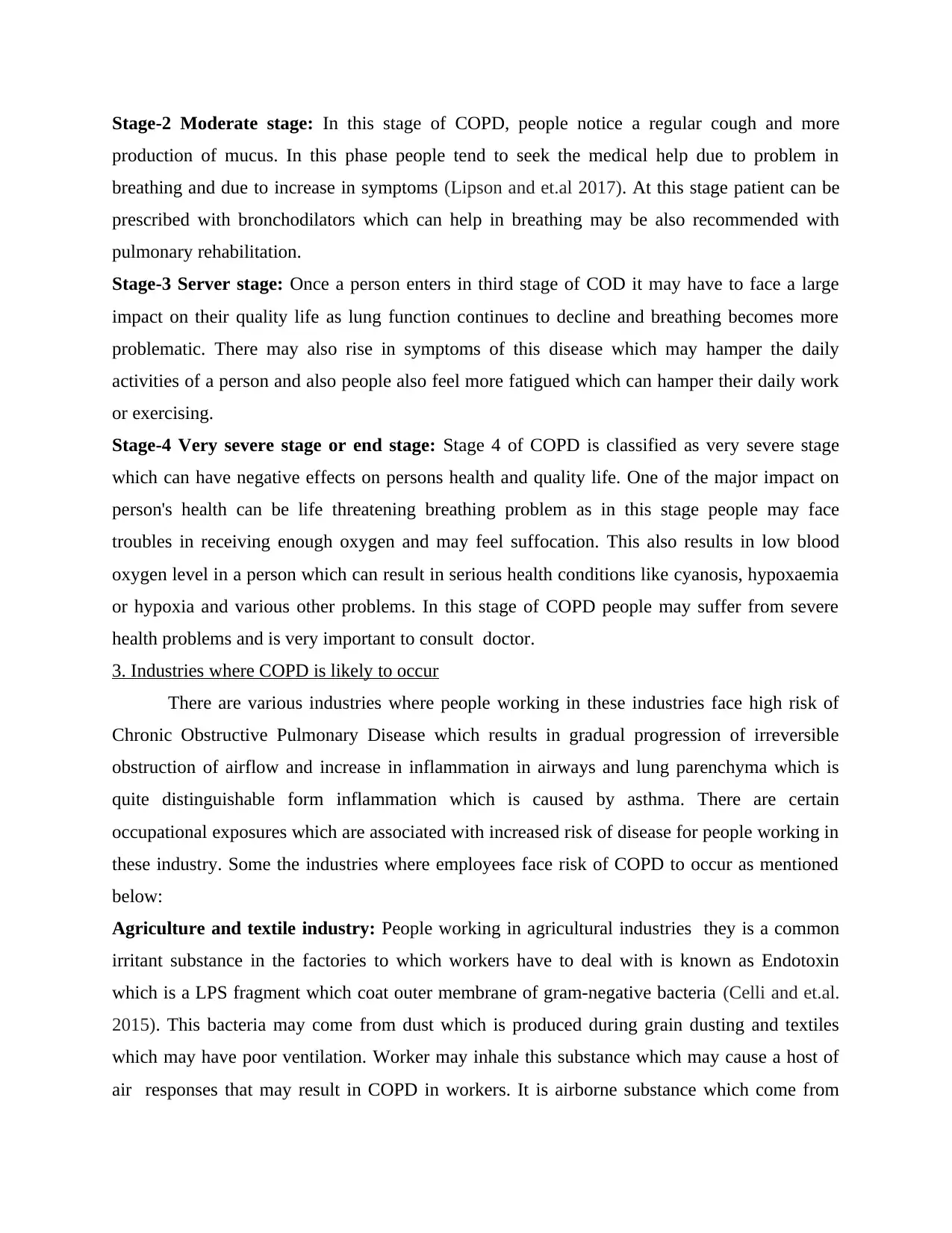
Stage-2 Moderate stage: In this stage of COPD, people notice a regular cough and more
production of mucus. In this phase people tend to seek the medical help due to problem in
breathing and due to increase in symptoms (Lipson and et.al 2017). At this stage patient can be
prescribed with bronchodilators which can help in breathing may be also recommended with
pulmonary rehabilitation.
Stage-3 Server stage: Once a person enters in third stage of COD it may have to face a large
impact on their quality life as lung function continues to decline and breathing becomes more
problematic. There may also rise in symptoms of this disease which may hamper the daily
activities of a person and also people also feel more fatigued which can hamper their daily work
or exercising.
Stage-4 Very severe stage or end stage: Stage 4 of COPD is classified as very severe stage
which can have negative effects on persons health and quality life. One of the major impact on
person's health can be life threatening breathing problem as in this stage people may face
troubles in receiving enough oxygen and may feel suffocation. This also results in low blood
oxygen level in a person which can result in serious health conditions like cyanosis, hypoxaemia
or hypoxia and various other problems. In this stage of COPD people may suffer from severe
health problems and is very important to consult doctor.
3. Industries where COPD is likely to occur
There are various industries where people working in these industries face high risk of
Chronic Obstructive Pulmonary Disease which results in gradual progression of irreversible
obstruction of airflow and increase in inflammation in airways and lung parenchyma which is
quite distinguishable form inflammation which is caused by asthma. There are certain
occupational exposures which are associated with increased risk of disease for people working in
these industry. Some the industries where employees face risk of COPD to occur as mentioned
below:
Agriculture and textile industry: People working in agricultural industries they is a common
irritant substance in the factories to which workers have to deal with is known as Endotoxin
which is a LPS fragment which coat outer membrane of gram-negative bacteria (Celli and et.al.
2015). This bacteria may come from dust which is produced during grain dusting and textiles
which may have poor ventilation. Worker may inhale this substance which may cause a host of
air responses that may result in COPD in workers. It is airborne substance which come from
production of mucus. In this phase people tend to seek the medical help due to problem in
breathing and due to increase in symptoms (Lipson and et.al 2017). At this stage patient can be
prescribed with bronchodilators which can help in breathing may be also recommended with
pulmonary rehabilitation.
Stage-3 Server stage: Once a person enters in third stage of COD it may have to face a large
impact on their quality life as lung function continues to decline and breathing becomes more
problematic. There may also rise in symptoms of this disease which may hamper the daily
activities of a person and also people also feel more fatigued which can hamper their daily work
or exercising.
Stage-4 Very severe stage or end stage: Stage 4 of COPD is classified as very severe stage
which can have negative effects on persons health and quality life. One of the major impact on
person's health can be life threatening breathing problem as in this stage people may face
troubles in receiving enough oxygen and may feel suffocation. This also results in low blood
oxygen level in a person which can result in serious health conditions like cyanosis, hypoxaemia
or hypoxia and various other problems. In this stage of COPD people may suffer from severe
health problems and is very important to consult doctor.
3. Industries where COPD is likely to occur
There are various industries where people working in these industries face high risk of
Chronic Obstructive Pulmonary Disease which results in gradual progression of irreversible
obstruction of airflow and increase in inflammation in airways and lung parenchyma which is
quite distinguishable form inflammation which is caused by asthma. There are certain
occupational exposures which are associated with increased risk of disease for people working in
these industry. Some the industries where employees face risk of COPD to occur as mentioned
below:
Agriculture and textile industry: People working in agricultural industries they is a common
irritant substance in the factories to which workers have to deal with is known as Endotoxin
which is a LPS fragment which coat outer membrane of gram-negative bacteria (Celli and et.al.
2015). This bacteria may come from dust which is produced during grain dusting and textiles
which may have poor ventilation. Worker may inhale this substance which may cause a host of
air responses that may result in COPD in workers. It is airborne substance which come from
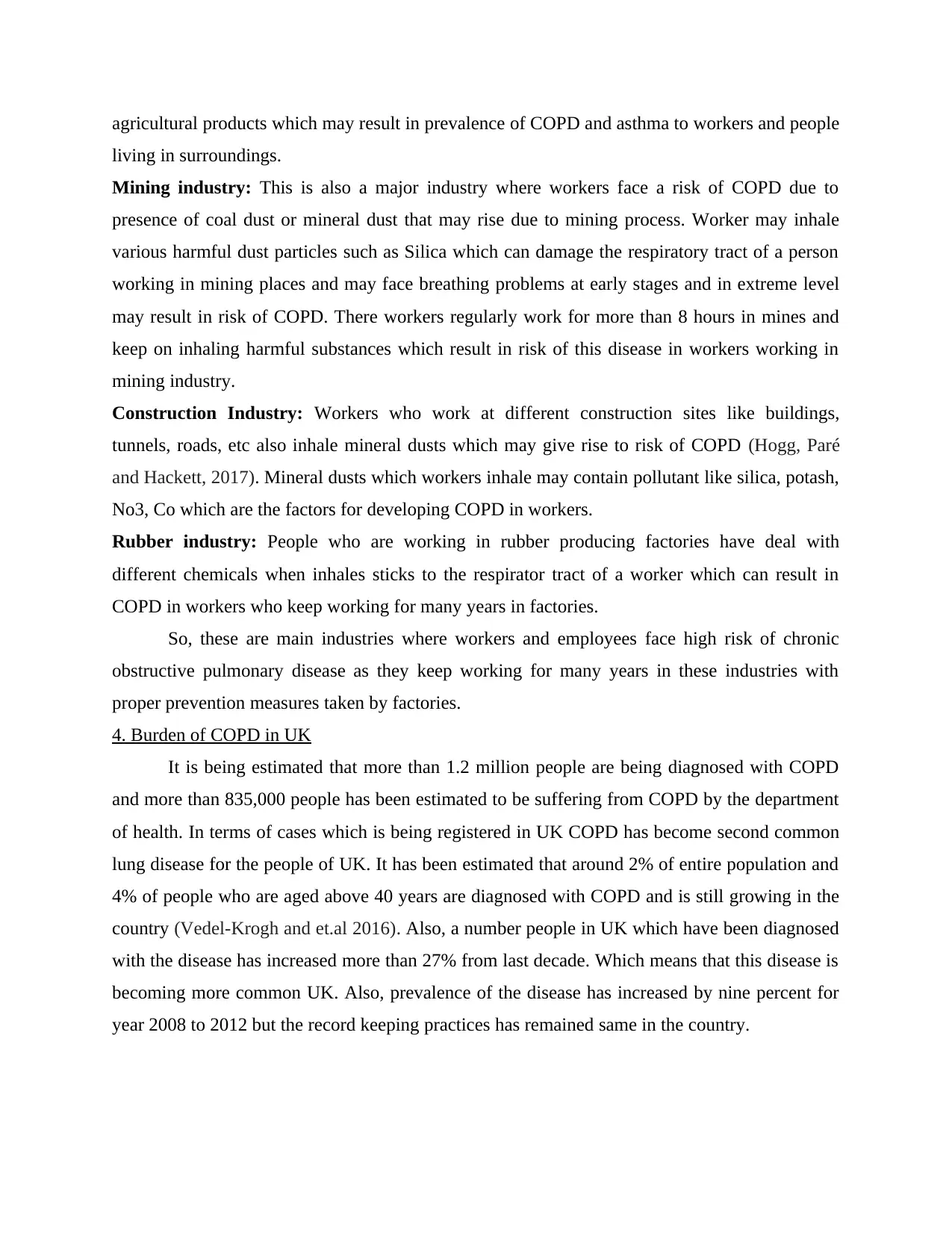
agricultural products which may result in prevalence of COPD and asthma to workers and people
living in surroundings.
Mining industry: This is also a major industry where workers face a risk of COPD due to
presence of coal dust or mineral dust that may rise due to mining process. Worker may inhale
various harmful dust particles such as Silica which can damage the respiratory tract of a person
working in mining places and may face breathing problems at early stages and in extreme level
may result in risk of COPD. There workers regularly work for more than 8 hours in mines and
keep on inhaling harmful substances which result in risk of this disease in workers working in
mining industry.
Construction Industry: Workers who work at different construction sites like buildings,
tunnels, roads, etc also inhale mineral dusts which may give rise to risk of COPD (Hogg, Paré
and Hackett, 2017). Mineral dusts which workers inhale may contain pollutant like silica, potash,
No3, Co which are the factors for developing COPD in workers.
Rubber industry: People who are working in rubber producing factories have deal with
different chemicals when inhales sticks to the respirator tract of a worker which can result in
COPD in workers who keep working for many years in factories.
So, these are main industries where workers and employees face high risk of chronic
obstructive pulmonary disease as they keep working for many years in these industries with
proper prevention measures taken by factories.
4. Burden of COPD in UK
It is being estimated that more than 1.2 million people are being diagnosed with COPD
and more than 835,000 people has been estimated to be suffering from COPD by the department
of health. In terms of cases which is being registered in UK COPD has become second common
lung disease for the people of UK. It has been estimated that around 2% of entire population and
4% of people who are aged above 40 years are diagnosed with COPD and is still growing in the
country (Vedel-Krogh and et.al 2016). Also, a number people in UK which have been diagnosed
with the disease has increased more than 27% from last decade. Which means that this disease is
becoming more common UK. Also, prevalence of the disease has increased by nine percent for
year 2008 to 2012 but the record keeping practices has remained same in the country.
living in surroundings.
Mining industry: This is also a major industry where workers face a risk of COPD due to
presence of coal dust or mineral dust that may rise due to mining process. Worker may inhale
various harmful dust particles such as Silica which can damage the respiratory tract of a person
working in mining places and may face breathing problems at early stages and in extreme level
may result in risk of COPD. There workers regularly work for more than 8 hours in mines and
keep on inhaling harmful substances which result in risk of this disease in workers working in
mining industry.
Construction Industry: Workers who work at different construction sites like buildings,
tunnels, roads, etc also inhale mineral dusts which may give rise to risk of COPD (Hogg, Paré
and Hackett, 2017). Mineral dusts which workers inhale may contain pollutant like silica, potash,
No3, Co which are the factors for developing COPD in workers.
Rubber industry: People who are working in rubber producing factories have deal with
different chemicals when inhales sticks to the respirator tract of a worker which can result in
COPD in workers who keep working for many years in factories.
So, these are main industries where workers and employees face high risk of chronic
obstructive pulmonary disease as they keep working for many years in these industries with
proper prevention measures taken by factories.
4. Burden of COPD in UK
It is being estimated that more than 1.2 million people are being diagnosed with COPD
and more than 835,000 people has been estimated to be suffering from COPD by the department
of health. In terms of cases which is being registered in UK COPD has become second common
lung disease for the people of UK. It has been estimated that around 2% of entire population and
4% of people who are aged above 40 years are diagnosed with COPD and is still growing in the
country (Vedel-Krogh and et.al 2016). Also, a number people in UK which have been diagnosed
with the disease has increased more than 27% from last decade. Which means that this disease is
becoming more common UK. Also, prevalence of the disease has increased by nine percent for
year 2008 to 2012 but the record keeping practices has remained same in the country.
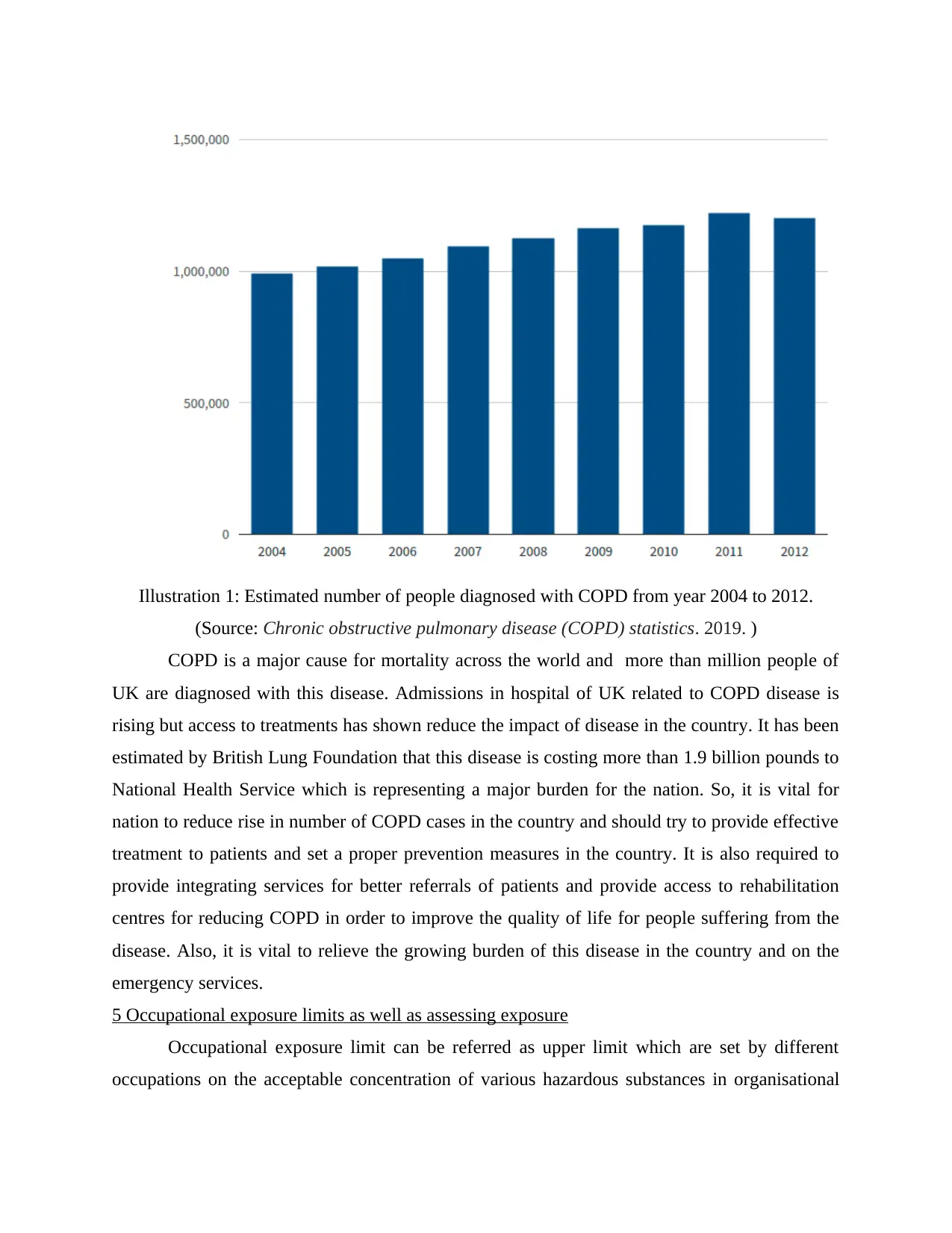
Illustration 1: Estimated number of people diagnosed with COPD from year 2004 to 2012.
(Source: Chronic obstructive pulmonary disease (COPD) statistics. 2019. )
COPD is a major cause for mortality across the world and more than million people of
UK are diagnosed with this disease. Admissions in hospital of UK related to COPD disease is
rising but access to treatments has shown reduce the impact of disease in the country. It has been
estimated by British Lung Foundation that this disease is costing more than 1.9 billion pounds to
National Health Service which is representing a major burden for the nation. So, it is vital for
nation to reduce rise in number of COPD cases in the country and should try to provide effective
treatment to patients and set a proper prevention measures in the country. It is also required to
provide integrating services for better referrals of patients and provide access to rehabilitation
centres for reducing COPD in order to improve the quality of life for people suffering from the
disease. Also, it is vital to relieve the growing burden of this disease in the country and on the
emergency services.
5 Occupational exposure limits as well as assessing exposure
Occupational exposure limit can be referred as upper limit which are set by different
occupations on the acceptable concentration of various hazardous substances in organisational
(Source: Chronic obstructive pulmonary disease (COPD) statistics. 2019. )
COPD is a major cause for mortality across the world and more than million people of
UK are diagnosed with this disease. Admissions in hospital of UK related to COPD disease is
rising but access to treatments has shown reduce the impact of disease in the country. It has been
estimated by British Lung Foundation that this disease is costing more than 1.9 billion pounds to
National Health Service which is representing a major burden for the nation. So, it is vital for
nation to reduce rise in number of COPD cases in the country and should try to provide effective
treatment to patients and set a proper prevention measures in the country. It is also required to
provide integrating services for better referrals of patients and provide access to rehabilitation
centres for reducing COPD in order to improve the quality of life for people suffering from the
disease. Also, it is vital to relieve the growing burden of this disease in the country and on the
emergency services.
5 Occupational exposure limits as well as assessing exposure
Occupational exposure limit can be referred as upper limit which are set by different
occupations on the acceptable concentration of various hazardous substances in organisational
Paraphrase This Document
Need a fresh take? Get an instant paraphrase of this document with our AI Paraphraser
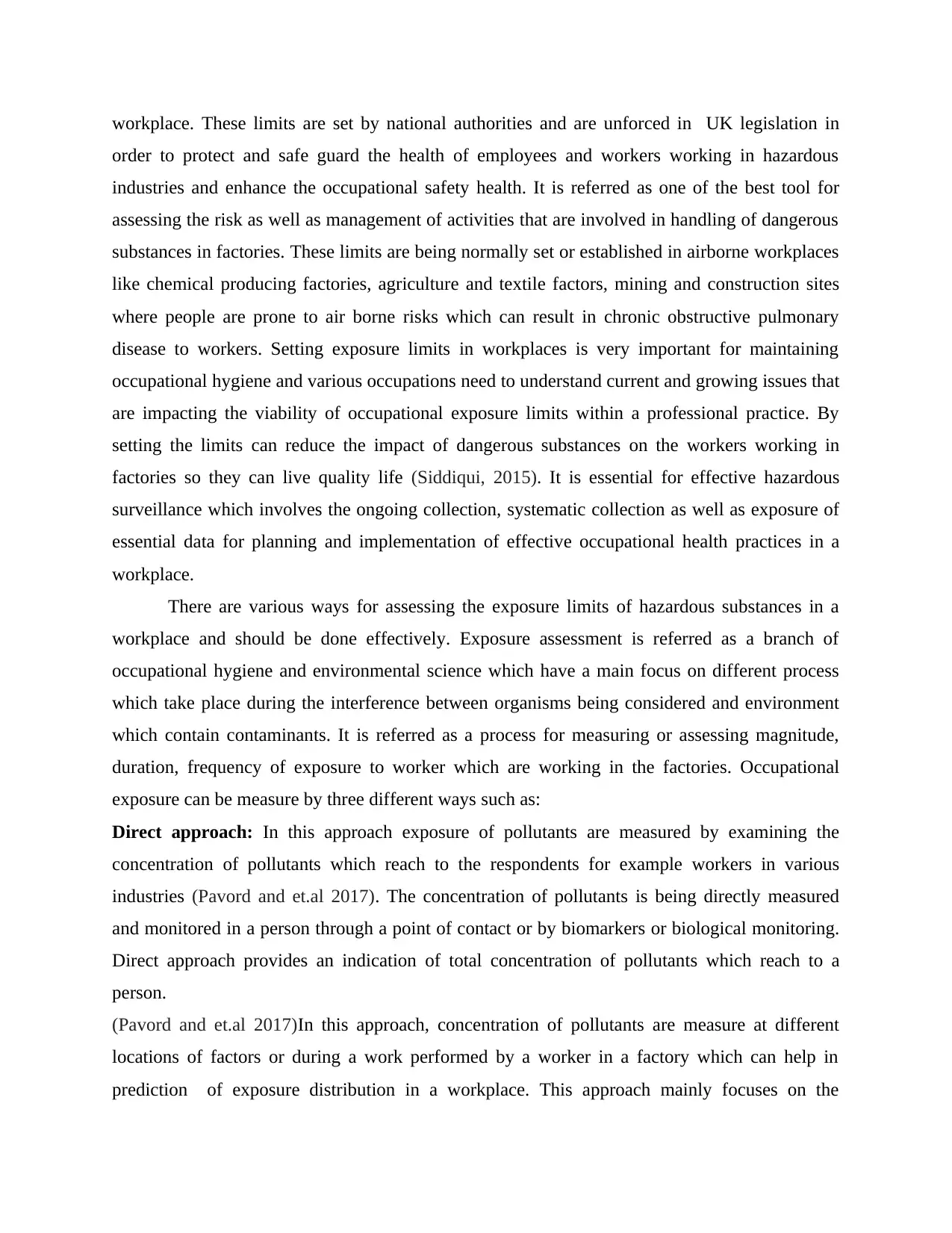
workplace. These limits are set by national authorities and are unforced in UK legislation in
order to protect and safe guard the health of employees and workers working in hazardous
industries and enhance the occupational safety health. It is referred as one of the best tool for
assessing the risk as well as management of activities that are involved in handling of dangerous
substances in factories. These limits are being normally set or established in airborne workplaces
like chemical producing factories, agriculture and textile factors, mining and construction sites
where people are prone to air borne risks which can result in chronic obstructive pulmonary
disease to workers. Setting exposure limits in workplaces is very important for maintaining
occupational hygiene and various occupations need to understand current and growing issues that
are impacting the viability of occupational exposure limits within a professional practice. By
setting the limits can reduce the impact of dangerous substances on the workers working in
factories so they can live quality life (Siddiqui, 2015). It is essential for effective hazardous
surveillance which involves the ongoing collection, systematic collection as well as exposure of
essential data for planning and implementation of effective occupational health practices in a
workplace.
There are various ways for assessing the exposure limits of hazardous substances in a
workplace and should be done effectively. Exposure assessment is referred as a branch of
occupational hygiene and environmental science which have a main focus on different process
which take place during the interference between organisms being considered and environment
which contain contaminants. It is referred as a process for measuring or assessing magnitude,
duration, frequency of exposure to worker which are working in the factories. Occupational
exposure can be measure by three different ways such as:
Direct approach: In this approach exposure of pollutants are measured by examining the
concentration of pollutants which reach to the respondents for example workers in various
industries (Pavord and et.al 2017). The concentration of pollutants is being directly measured
and monitored in a person through a point of contact or by biomarkers or biological monitoring.
Direct approach provides an indication of total concentration of pollutants which reach to a
person.
(Pavord and et.al 2017)In this approach, concentration of pollutants are measure at different
locations of factors or during a work performed by a worker in a factory which can help in
prediction of exposure distribution in a workplace. This approach mainly focuses on the
order to protect and safe guard the health of employees and workers working in hazardous
industries and enhance the occupational safety health. It is referred as one of the best tool for
assessing the risk as well as management of activities that are involved in handling of dangerous
substances in factories. These limits are being normally set or established in airborne workplaces
like chemical producing factories, agriculture and textile factors, mining and construction sites
where people are prone to air borne risks which can result in chronic obstructive pulmonary
disease to workers. Setting exposure limits in workplaces is very important for maintaining
occupational hygiene and various occupations need to understand current and growing issues that
are impacting the viability of occupational exposure limits within a professional practice. By
setting the limits can reduce the impact of dangerous substances on the workers working in
factories so they can live quality life (Siddiqui, 2015). It is essential for effective hazardous
surveillance which involves the ongoing collection, systematic collection as well as exposure of
essential data for planning and implementation of effective occupational health practices in a
workplace.
There are various ways for assessing the exposure limits of hazardous substances in a
workplace and should be done effectively. Exposure assessment is referred as a branch of
occupational hygiene and environmental science which have a main focus on different process
which take place during the interference between organisms being considered and environment
which contain contaminants. It is referred as a process for measuring or assessing magnitude,
duration, frequency of exposure to worker which are working in the factories. Occupational
exposure can be measure by three different ways such as:
Direct approach: In this approach exposure of pollutants are measured by examining the
concentration of pollutants which reach to the respondents for example workers in various
industries (Pavord and et.al 2017). The concentration of pollutants is being directly measured
and monitored in a person through a point of contact or by biomarkers or biological monitoring.
Direct approach provides an indication of total concentration of pollutants which reach to a
person.
(Pavord and et.al 2017)In this approach, concentration of pollutants are measure at different
locations of factors or during a work performed by a worker in a factory which can help in
prediction of exposure distribution in a workplace. This approach mainly focuses on the
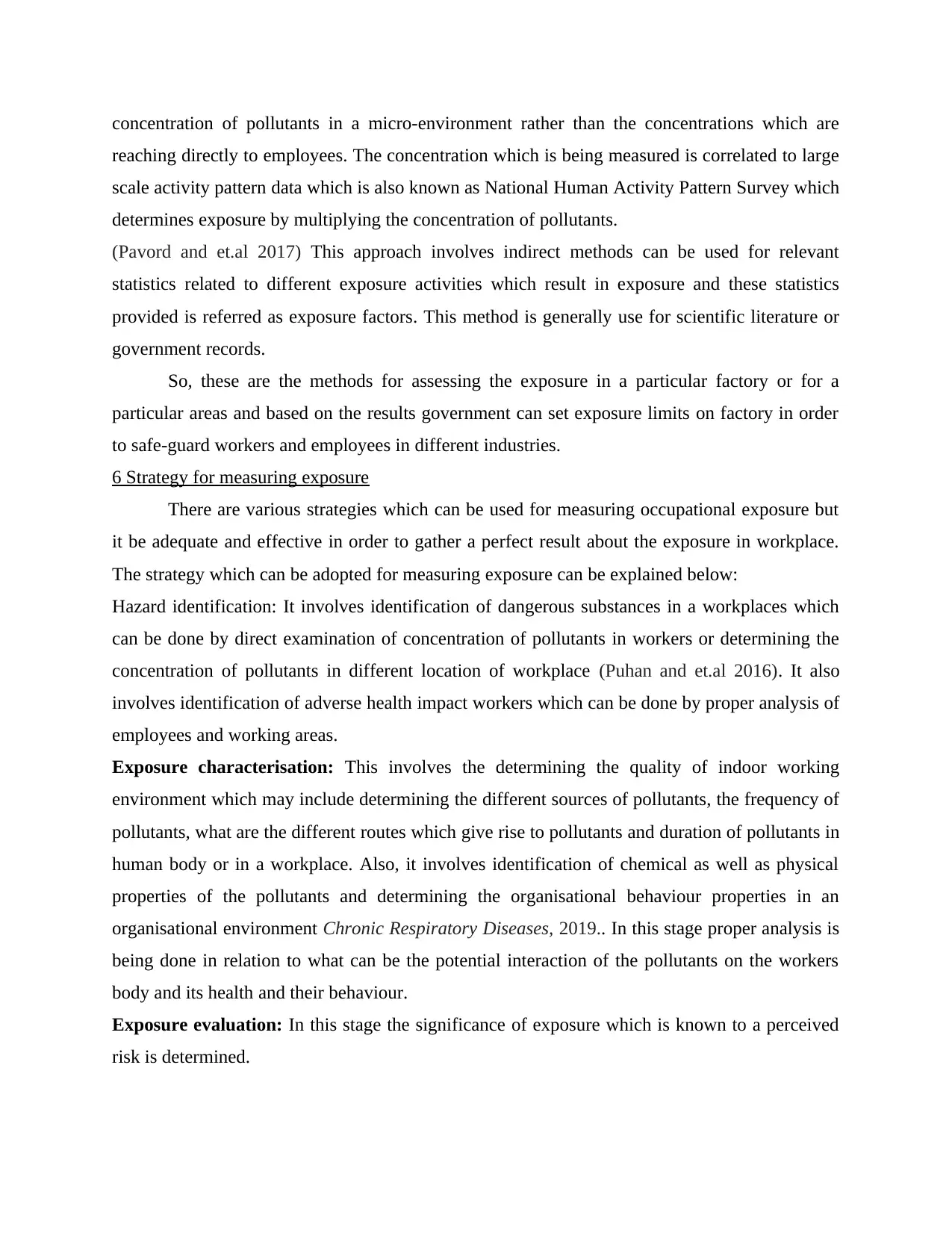
concentration of pollutants in a micro-environment rather than the concentrations which are
reaching directly to employees. The concentration which is being measured is correlated to large
scale activity pattern data which is also known as National Human Activity Pattern Survey which
determines exposure by multiplying the concentration of pollutants.
(Pavord and et.al 2017) This approach involves indirect methods can be used for relevant
statistics related to different exposure activities which result in exposure and these statistics
provided is referred as exposure factors. This method is generally use for scientific literature or
government records.
So, these are the methods for assessing the exposure in a particular factory or for a
particular areas and based on the results government can set exposure limits on factory in order
to safe-guard workers and employees in different industries.
6 Strategy for measuring exposure
There are various strategies which can be used for measuring occupational exposure but
it be adequate and effective in order to gather a perfect result about the exposure in workplace.
The strategy which can be adopted for measuring exposure can be explained below:
Hazard identification: It involves identification of dangerous substances in a workplaces which
can be done by direct examination of concentration of pollutants in workers or determining the
concentration of pollutants in different location of workplace (Puhan and et.al 2016). It also
involves identification of adverse health impact workers which can be done by proper analysis of
employees and working areas.
Exposure characterisation: This involves the determining the quality of indoor working
environment which may include determining the different sources of pollutants, the frequency of
pollutants, what are the different routes which give rise to pollutants and duration of pollutants in
human body or in a workplace. Also, it involves identification of chemical as well as physical
properties of the pollutants and determining the organisational behaviour properties in an
organisational environment Chronic Respiratory Diseases, 2019.. In this stage proper analysis is
being done in relation to what can be the potential interaction of the pollutants on the workers
body and its health and their behaviour.
Exposure evaluation: In this stage the significance of exposure which is known to a perceived
risk is determined.
reaching directly to employees. The concentration which is being measured is correlated to large
scale activity pattern data which is also known as National Human Activity Pattern Survey which
determines exposure by multiplying the concentration of pollutants.
(Pavord and et.al 2017) This approach involves indirect methods can be used for relevant
statistics related to different exposure activities which result in exposure and these statistics
provided is referred as exposure factors. This method is generally use for scientific literature or
government records.
So, these are the methods for assessing the exposure in a particular factory or for a
particular areas and based on the results government can set exposure limits on factory in order
to safe-guard workers and employees in different industries.
6 Strategy for measuring exposure
There are various strategies which can be used for measuring occupational exposure but
it be adequate and effective in order to gather a perfect result about the exposure in workplace.
The strategy which can be adopted for measuring exposure can be explained below:
Hazard identification: It involves identification of dangerous substances in a workplaces which
can be done by direct examination of concentration of pollutants in workers or determining the
concentration of pollutants in different location of workplace (Puhan and et.al 2016). It also
involves identification of adverse health impact workers which can be done by proper analysis of
employees and working areas.
Exposure characterisation: This involves the determining the quality of indoor working
environment which may include determining the different sources of pollutants, the frequency of
pollutants, what are the different routes which give rise to pollutants and duration of pollutants in
human body or in a workplace. Also, it involves identification of chemical as well as physical
properties of the pollutants and determining the organisational behaviour properties in an
organisational environment Chronic Respiratory Diseases, 2019.. In this stage proper analysis is
being done in relation to what can be the potential interaction of the pollutants on the workers
body and its health and their behaviour.
Exposure evaluation: In this stage the significance of exposure which is known to a perceived
risk is determined.
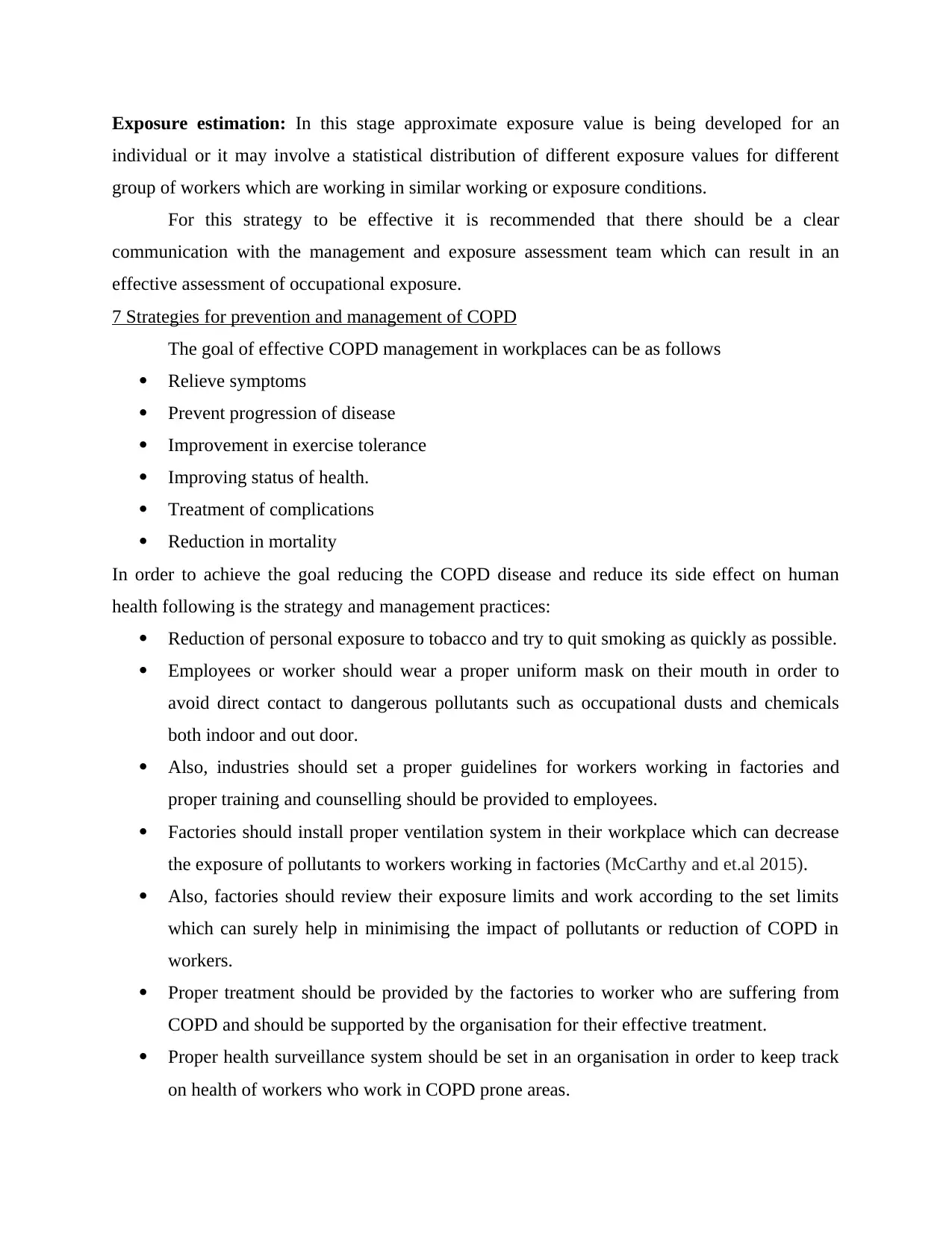
Exposure estimation: In this stage approximate exposure value is being developed for an
individual or it may involve a statistical distribution of different exposure values for different
group of workers which are working in similar working or exposure conditions.
For this strategy to be effective it is recommended that there should be a clear
communication with the management and exposure assessment team which can result in an
effective assessment of occupational exposure.
7 Strategies for prevention and management of COPD
The goal of effective COPD management in workplaces can be as follows
Relieve symptoms
Prevent progression of disease
Improvement in exercise tolerance
Improving status of health.
Treatment of complications
Reduction in mortality
In order to achieve the goal reducing the COPD disease and reduce its side effect on human
health following is the strategy and management practices:
Reduction of personal exposure to tobacco and try to quit smoking as quickly as possible.
Employees or worker should wear a proper uniform mask on their mouth in order to
avoid direct contact to dangerous pollutants such as occupational dusts and chemicals
both indoor and out door.
Also, industries should set a proper guidelines for workers working in factories and
proper training and counselling should be provided to employees.
Factories should install proper ventilation system in their workplace which can decrease
the exposure of pollutants to workers working in factories (McCarthy and et.al 2015).
Also, factories should review their exposure limits and work according to the set limits
which can surely help in minimising the impact of pollutants or reduction of COPD in
workers.
Proper treatment should be provided by the factories to worker who are suffering from
COPD and should be supported by the organisation for their effective treatment.
Proper health surveillance system should be set in an organisation in order to keep track
on health of workers who work in COPD prone areas.
individual or it may involve a statistical distribution of different exposure values for different
group of workers which are working in similar working or exposure conditions.
For this strategy to be effective it is recommended that there should be a clear
communication with the management and exposure assessment team which can result in an
effective assessment of occupational exposure.
7 Strategies for prevention and management of COPD
The goal of effective COPD management in workplaces can be as follows
Relieve symptoms
Prevent progression of disease
Improvement in exercise tolerance
Improving status of health.
Treatment of complications
Reduction in mortality
In order to achieve the goal reducing the COPD disease and reduce its side effect on human
health following is the strategy and management practices:
Reduction of personal exposure to tobacco and try to quit smoking as quickly as possible.
Employees or worker should wear a proper uniform mask on their mouth in order to
avoid direct contact to dangerous pollutants such as occupational dusts and chemicals
both indoor and out door.
Also, industries should set a proper guidelines for workers working in factories and
proper training and counselling should be provided to employees.
Factories should install proper ventilation system in their workplace which can decrease
the exposure of pollutants to workers working in factories (McCarthy and et.al 2015).
Also, factories should review their exposure limits and work according to the set limits
which can surely help in minimising the impact of pollutants or reduction of COPD in
workers.
Proper treatment should be provided by the factories to worker who are suffering from
COPD and should be supported by the organisation for their effective treatment.
Proper health surveillance system should be set in an organisation in order to keep track
on health of workers who work in COPD prone areas.
Secure Best Marks with AI Grader
Need help grading? Try our AI Grader for instant feedback on your assignments.
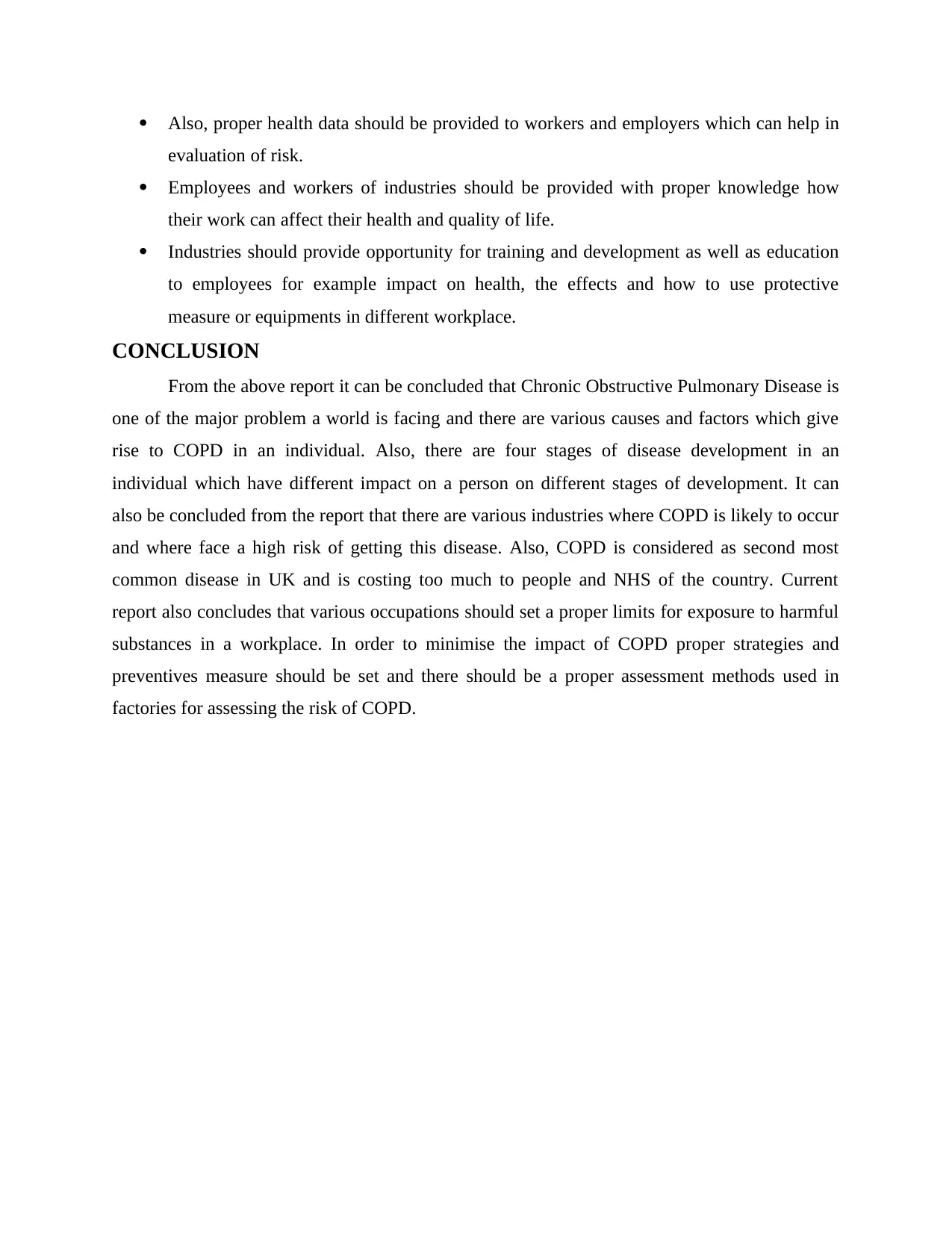
Also, proper health data should be provided to workers and employers which can help in
evaluation of risk.
Employees and workers of industries should be provided with proper knowledge how
their work can affect their health and quality of life.
Industries should provide opportunity for training and development as well as education
to employees for example impact on health, the effects and how to use protective
measure or equipments in different workplace.
CONCLUSION
From the above report it can be concluded that Chronic Obstructive Pulmonary Disease is
one of the major problem a world is facing and there are various causes and factors which give
rise to COPD in an individual. Also, there are four stages of disease development in an
individual which have different impact on a person on different stages of development. It can
also be concluded from the report that there are various industries where COPD is likely to occur
and where face a high risk of getting this disease. Also, COPD is considered as second most
common disease in UK and is costing too much to people and NHS of the country. Current
report also concludes that various occupations should set a proper limits for exposure to harmful
substances in a workplace. In order to minimise the impact of COPD proper strategies and
preventives measure should be set and there should be a proper assessment methods used in
factories for assessing the risk of COPD.
evaluation of risk.
Employees and workers of industries should be provided with proper knowledge how
their work can affect their health and quality of life.
Industries should provide opportunity for training and development as well as education
to employees for example impact on health, the effects and how to use protective
measure or equipments in different workplace.
CONCLUSION
From the above report it can be concluded that Chronic Obstructive Pulmonary Disease is
one of the major problem a world is facing and there are various causes and factors which give
rise to COPD in an individual. Also, there are four stages of disease development in an
individual which have different impact on a person on different stages of development. It can
also be concluded from the report that there are various industries where COPD is likely to occur
and where face a high risk of getting this disease. Also, COPD is considered as second most
common disease in UK and is costing too much to people and NHS of the country. Current
report also concludes that various occupations should set a proper limits for exposure to harmful
substances in a workplace. In order to minimise the impact of COPD proper strategies and
preventives measure should be set and there should be a proper assessment methods used in
factories for assessing the risk of COPD.
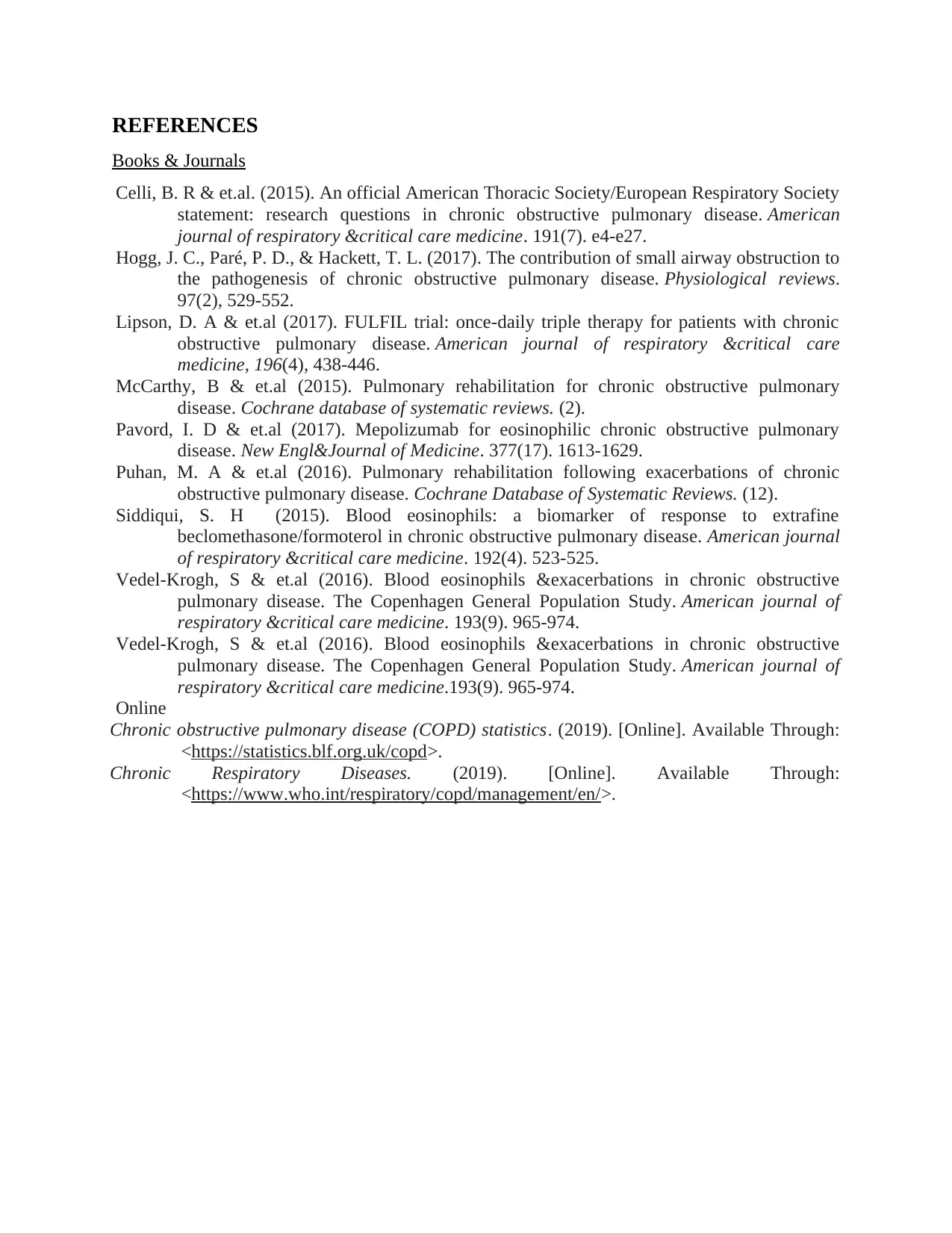
REFERENCES
Books & Journals
Celli, B. R & et.al. (2015). An official American Thoracic Society/European Respiratory Society
statement: research questions in chronic obstructive pulmonary disease. American
journal of respiratory &critical care medicine. 191(7). e4-e27.
Hogg, J. C., Paré, P. D., & Hackett, T. L. (2017). The contribution of small airway obstruction to
the pathogenesis of chronic obstructive pulmonary disease. Physiological reviews.
97(2), 529-552.
Lipson, D. A & et.al (2017). FULFIL trial: once-daily triple therapy for patients with chronic
obstructive pulmonary disease. American journal of respiratory &critical care
medicine, 196(4), 438-446.
McCarthy, B & et.al (2015). Pulmonary rehabilitation for chronic obstructive pulmonary
disease. Cochrane database of systematic reviews. (2).
Pavord, I. D & et.al (2017). Mepolizumab for eosinophilic chronic obstructive pulmonary
disease. New Engl&Journal of Medicine. 377(17). 1613-1629.
Puhan, M. A & et.al (2016). Pulmonary rehabilitation following exacerbations of chronic
obstructive pulmonary disease. Cochrane Database of Systematic Reviews. (12).
Siddiqui, S. H (2015). Blood eosinophils: a biomarker of response to extrafine
beclomethasone/formoterol in chronic obstructive pulmonary disease. American journal
of respiratory &critical care medicine. 192(4). 523-525.
Vedel-Krogh, S & et.al (2016). Blood eosinophils &exacerbations in chronic obstructive
pulmonary disease. The Copenhagen General Population Study. American journal of
respiratory &critical care medicine. 193(9). 965-974.
Vedel-Krogh, S & et.al (2016). Blood eosinophils &exacerbations in chronic obstructive
pulmonary disease. The Copenhagen General Population Study. American journal of
respiratory &critical care medicine.193(9). 965-974.
Online
Chronic obstructive pulmonary disease (COPD) statistics. (2019). [Online]. Available Through:
<https://statistics.blf.org.uk/copd>.
Chronic Respiratory Diseases. (2019). [Online]. Available Through:
<https://www.who.int/respiratory/copd/management/en/>.
Books & Journals
Celli, B. R & et.al. (2015). An official American Thoracic Society/European Respiratory Society
statement: research questions in chronic obstructive pulmonary disease. American
journal of respiratory &critical care medicine. 191(7). e4-e27.
Hogg, J. C., Paré, P. D., & Hackett, T. L. (2017). The contribution of small airway obstruction to
the pathogenesis of chronic obstructive pulmonary disease. Physiological reviews.
97(2), 529-552.
Lipson, D. A & et.al (2017). FULFIL trial: once-daily triple therapy for patients with chronic
obstructive pulmonary disease. American journal of respiratory &critical care
medicine, 196(4), 438-446.
McCarthy, B & et.al (2015). Pulmonary rehabilitation for chronic obstructive pulmonary
disease. Cochrane database of systematic reviews. (2).
Pavord, I. D & et.al (2017). Mepolizumab for eosinophilic chronic obstructive pulmonary
disease. New Engl&Journal of Medicine. 377(17). 1613-1629.
Puhan, M. A & et.al (2016). Pulmonary rehabilitation following exacerbations of chronic
obstructive pulmonary disease. Cochrane Database of Systematic Reviews. (12).
Siddiqui, S. H (2015). Blood eosinophils: a biomarker of response to extrafine
beclomethasone/formoterol in chronic obstructive pulmonary disease. American journal
of respiratory &critical care medicine. 192(4). 523-525.
Vedel-Krogh, S & et.al (2016). Blood eosinophils &exacerbations in chronic obstructive
pulmonary disease. The Copenhagen General Population Study. American journal of
respiratory &critical care medicine. 193(9). 965-974.
Vedel-Krogh, S & et.al (2016). Blood eosinophils &exacerbations in chronic obstructive
pulmonary disease. The Copenhagen General Population Study. American journal of
respiratory &critical care medicine.193(9). 965-974.
Online
Chronic obstructive pulmonary disease (COPD) statistics. (2019). [Online]. Available Through:
<https://statistics.blf.org.uk/copd>.
Chronic Respiratory Diseases. (2019). [Online]. Available Through:
<https://www.who.int/respiratory/copd/management/en/>.
1 out of 12
Related Documents
Your All-in-One AI-Powered Toolkit for Academic Success.
+13062052269
info@desklib.com
Available 24*7 on WhatsApp / Email
![[object Object]](/_next/static/media/star-bottom.7253800d.svg)
Unlock your academic potential
© 2024 | Zucol Services PVT LTD | All rights reserved.




